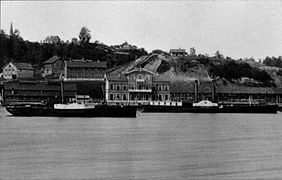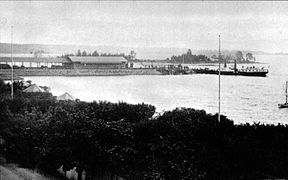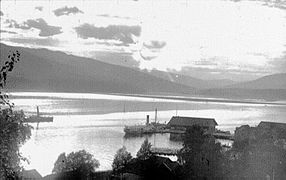Skibladner (ship)
|
||||||||||||||
|
||||||||||||||
|
||||||||||||||
|
||||||||||||||
The steamship Skibladner is a paddle steamer from the mid-19th century that was commissioned on the Norwegian lake Mjøsa on August 2, 1856 and is still in operation today. The Skibladner is also called the “White Swan of Mjøsa” and has been awarded the Olavsrose .
description
The Skibladner is the oldest paddle steamer in the world still in operation. In Norway, the ship is a very well known and popular tourist attraction. The ship belongs to the shipping company A / S Oplandske Dampskibsselskap, founded in 1852 . Originally two ships of the type of paddle steamer were ordered, the first of which is called Færdesmannen from Akers Mek. Verksted shipyard in Oslo began operations in July 1856. The Færdesmannen was the first Norwegian steamship. Shortly after the launch of the Færdesmannen in was Motala ( Sweden built) Skibladner , the new flagship of the shipping company. The individual parts of the Skibladner were transported from Sweden by ship and train to Lake Mjøsa - Norway's largest lake - near Minnesund , near Eidsvoll, and assembled on site. The maiden voyage took place on August 2, 1856. To this day, the ship has been operating as a traditional mail ship and until 1919 carried mail on Mjøsa for eight to nine months a year during the ice-free period. After that, it was only used in summer. On June 14, 2005, the Riksantikvaren , the Norwegian authority responsible for the preservation and preservation of monuments, placed the Skibladner under monument protection . Today the ship is used as a tourist attraction.
The name probably goes back to the ship of the Norse mythology Skidbladnir .
Motorization
The Skibladner was originally powered by two machines with a total of 70 hp . This was enough for a top speed of 11 knots . A renovation in 1888, in which the ship was lengthened by six meters, new blades and a steam engine with 605 hp were installed, the speed could be increased to 13 knots. In 1920 the firing was switched from coal to oil. In 1993 the ship was largely restored and brought to the condition of 1888. Today's maximum speed is 12 knots, which corresponds to 22 km / h . The steam boiler from 1888 was replaced by a new boiler in 1984.
business
The Skibladner is in operation from the end of June to mid-August. Depending on the day of the week, the ship goes to the following places on Lake Mjøsa : Lillehammer , Moelv , Gjøvik , Kapp , Nes , Hamar , Totenvika and Eidsvoll . Skibladner needs two days to cross Eidsvoll at the southern end of Mjøsa to Lillehammer, about 100 km away, at the northern end of the lake . There are no trips on Mondays.
Historical recordings
literature
- HH Olstad, E. Knutsen: Skibladner 1856-1981 . A / S Oplandske Dampskibsselskap, 1981
- J. Jobé, RA Plummer, GW Hilton: Paddle steamers from all over the world , 1989 Augsburg, ISBN 3-89350-024-3
Web links
- The website of the paddle steamer (also in German)






